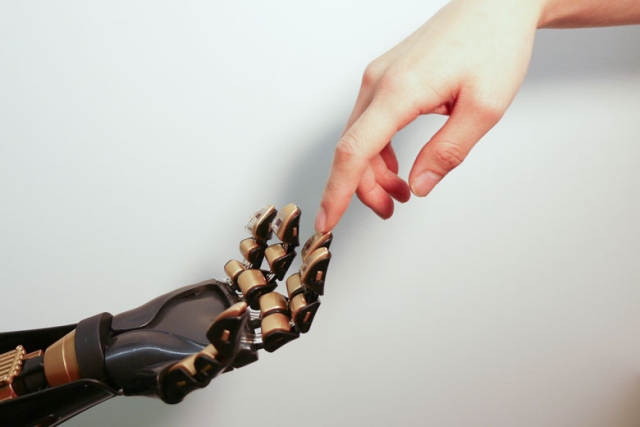Engineers at Stanford have developed an artificial, skin-like, plastic material that has the ability to detect pressure sensation, and also send this signal to a live brain cell.
 Stanford chemical engineering Professor Zhenan Bao and her team have created a skin-like material that can tell the difference between a soft touch and a firm handshake. The device on the golden “fingertip” is the skin-like sensor developed by Stanford engineers. (Bao Lab)
Stanford chemical engineering Professor Zhenan Bao and her team have created a skin-like material that can tell the difference between a soft touch and a firm handshake. The device on the golden “fingertip” is the skin-like sensor developed by Stanford engineers. (Bao Lab)
Stanford chemical engineering professor, Zhenan Bao, had spent around a decade developing a material that had the ability of the skin to heal and flex, whilst functioning as a sensor net that could send various signals such as pain, temperature and touch to the brain. She intends to develop a sensor-embedded flexible electronic fabric that could mimic sensory functions of the skin.
This fabric could be used as a cover for prosthetic limbs. This study denotes the advancement made towards mimicking touch sensation that helps differentiate between a firm grip and a limp handshake.
"This is the first time a flexible, skin-like material has been able to detect pressure and also transmit a signal to a component of the nervous system," said Bao, who led the 17-person research team responsible for the achievement.
The skin-like material developed by the researchers has a two-ply plastic construct. The top layer forms a sensing mechanism, while the bottom layer transports electrical signals, and converts them into biochemical stimuli that can function along with nerve cells. A sensor in the top layer has the capability to detect the same pressure range that human skin can detect.
In the past, members of Bao's team described the manner whereby rubbers and plastics could be used as pressure sensors through measurement of their molecular structure’s natural springiness. The team then indented a waffle pattern into the plastic material to further compress the molecular springs of the plastic.
Billions of carbon nanotubes were then dispersed throughout the waffled plastic in order to electronically harness the material’s capability to sense pressure. When pressure was applied to the plastic, it forced the nanotubes even closer together, which allowed them to conduct electricity.
The human skin transmits pressure information in the form of short electric pulses to the brain. These pulses are similar to Morse code. When more pressure is applied on the waffled nanotubes, it squeezes them closer together and enables a greater flow of electricity. The different pulses are then sent to the sensing mechanism in the form of short pulses. When the pressure is removed, the pulse flow reduces, and it would denote a light touch. When all the pressure is removed, the pulses stop completely. The pressure-sensing mechanism can be connected to the artificial skin material’s second ply.
PARC, a Xerox company, has developed technology to deposit flexible circuits onto plastic using an inkjet printer. Conversely, Bao's team has been involved in the development of flexible electronics that could remain unbreakable even after being subjected to bending. The members of Bao's team collaborated with PARC, as they had to achieve a large surface that could increase the feasibility of artificial skin.
The team then adopted a technique developed by optogenetics pioneer, Karl Deisseroth. Deisseroth is a fellow professor of bioengineering at Stanford. In this technique, cells are bioengineered so that they become sensitive to certain light frequencies. Light pulses are then used to switch on and off the processes inside the cells.
In order to simulate a section of the human nervous system, the researchers engineered a line of neurons. The electronic pressure signals were translated into light pulses that activated the neurons. This demonstrated that the artificial skin was capable of generating a sensory output that was compatible with nerve cells.
Bao stated that other methods apart from optogenetics could be used in real prosthetic devices for stimulating nerves. The possibility of direct stimulation of neurons using electrical pulses had already been demonstrated by collaboration with Bianxiao Cui, an associate professor of chemistry at Stanford.
Bao's team believes that it would be possible to develop different sensors that could mimic other senses, such as between a hot cup of coffee and cold glass of water, or between corduroy and silk. The human hand has six different types of biological sensing mechanisms, and the present experiment has been able to achieve just one of the sensing mechanisms.
The two-ply method will allow addition of more sensations as and when new mechanisms are developed. Furthermore, the inkjet printing fabrication process demonstrates the manner in which a sensor network could be deposited over a flexible material layer, and this could then be used to cover a prosthetic hand.
"We have a lot of work to take this from experimental to practical applications," Bao said. "But after spending many years in this work, I now see a clear path where we can take our artificial skin."
The lead authors of the study paper were Andre Berndt, a postdoctoral scholar in bioengineering; Alex Chortos, a doctoral candidate in materials science and engineering; and Benjamin Tee, a recent doctoral graduate in electrical engineering.
The study paper has been published in the journal, Science.